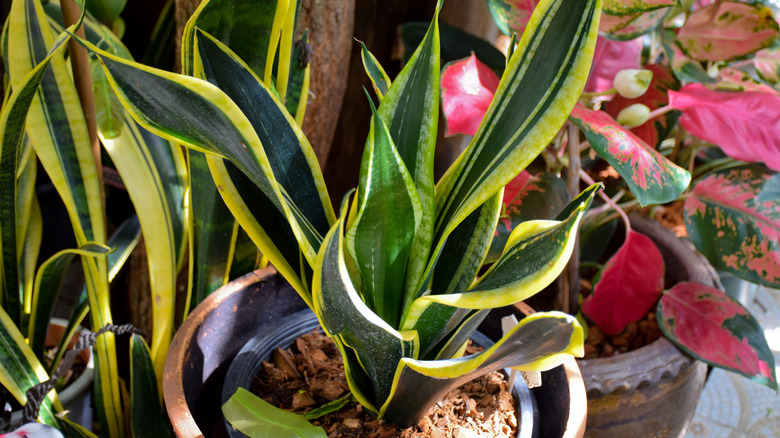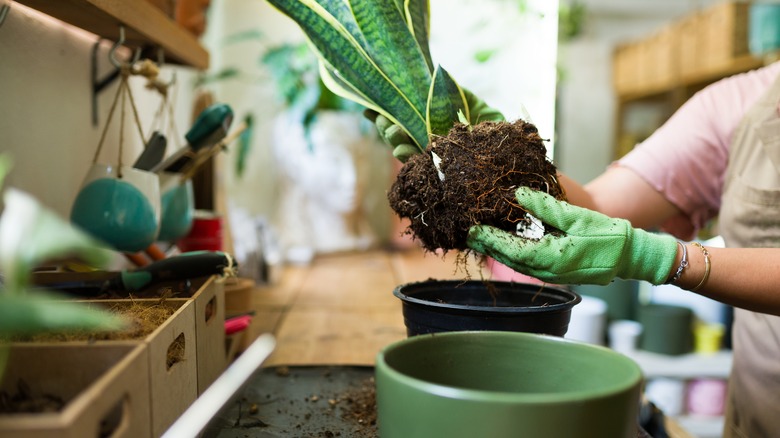This Is How Often You Should Be Fertilizing Your Snake Plant To Avoid Overdoing It
The snake plant (Dracaena trifasciata) is one of the hardiest plants that you could ever grow. This is what makes it such a popular houseplant for gardeners around the world. Its succulent leaves mean that it requires minimal watering and well-drained soil. It can also tolerate low light conditions and a range of temperatures. The snake plant is not a heavy feeder so you should make sure that you don't fertilize it too often as this can damage the plant.
Your snake plant should only be fertilized during its active growing season in spring and summer and fairly sparingly. It should not be fed in winter when it's dormant. Depending on what type of fertilizer you prefer to use, you could just feed it once a year with a slow-release one or once a month in spring and summer if you're using a liquid fertilizer. Make sure that this is used at half-strength, as showering your plants with nutrients is actually a bad idea. It's also important to note that the snake plant is mildly toxic to pets and humans. Plus, it's considered invasive in Florida. That's why it's better to grow this plant in a pot so that it does not spread through its underground rhizomes.
How and when to fertilize your snake plant
The snake plant doesn't need a lot of nutrients to remain healthy and thrive. It's native to West and Central Africa, which are known for having fairly poor soils, so snake plants have adapted to these types of growing conditions. However, because you're growing your snake plant in a pot, the potting soil will eventually run out of nutrients, and these will need to be replenished.
If you prefer to use a slow-release houseplant food in granular form, then you only need to apply a small dose once a year, either in spring or summer, when the plant is actively growing. This will provide your snake plant with enough nutrients to thrive and is actually the ideal form of fertilizer to use for these plants because it releases its nutrients only gradually. Make sure that you don't feed your snake plant in winter, as this is when it becomes dormant and won't take up the nutrients provided.
However, if you're more familiar with liquid fertilizers, these are usually fast-release which means that they'll make the nutrients available to your snake plant as soon as you apply them. If you prefer this method of fertilizing, then you can apply a liquid feed at half-strength once a month through spring and summer only. This will ensure that any excess nutrients will be leached out when you water your plant and thus, not do any damage to the roots of your snake plant.
Why you should avoid overfertilizing your snake plant
It's important to only feed your snake plant as per these recommendations and to use your chosen fertilizer fairly sparingly. Over-fertilizing can damage your plant's root system. When you apply more fertilizer than the plant can effectively use, the excess will accumulate as salts in the potting soil. These excess salts can actually burn the roots of your plant. This will result in wilting leaves and yellowing foliage. Another sign that your snake plant has been over-fertilized is a white crust appearing over the surface of the potting soil. In fact, over-fertilizing could be one of the reasons your houseplant leaves are turning yellow.
You can easily remedy this by flushing the excess salts out of the potting soil. To do this, you need to take your plant to the sink and flush the soil with water until the water flows freely from the drainage holes in the bottom of the pot. As the snake plant is succulent, make sure that you let it drain completely before putting it back in its spot in your home. You could also repot your snake plant into new, free-draining potting soil and reduce the amount of fertilizer that you're applying. But, if over-fertilizing is not a problem and your snake plant is not as healthy as it should be, you might want to check out the ultimate guide to saving a dying snake plant for more useful tips.


